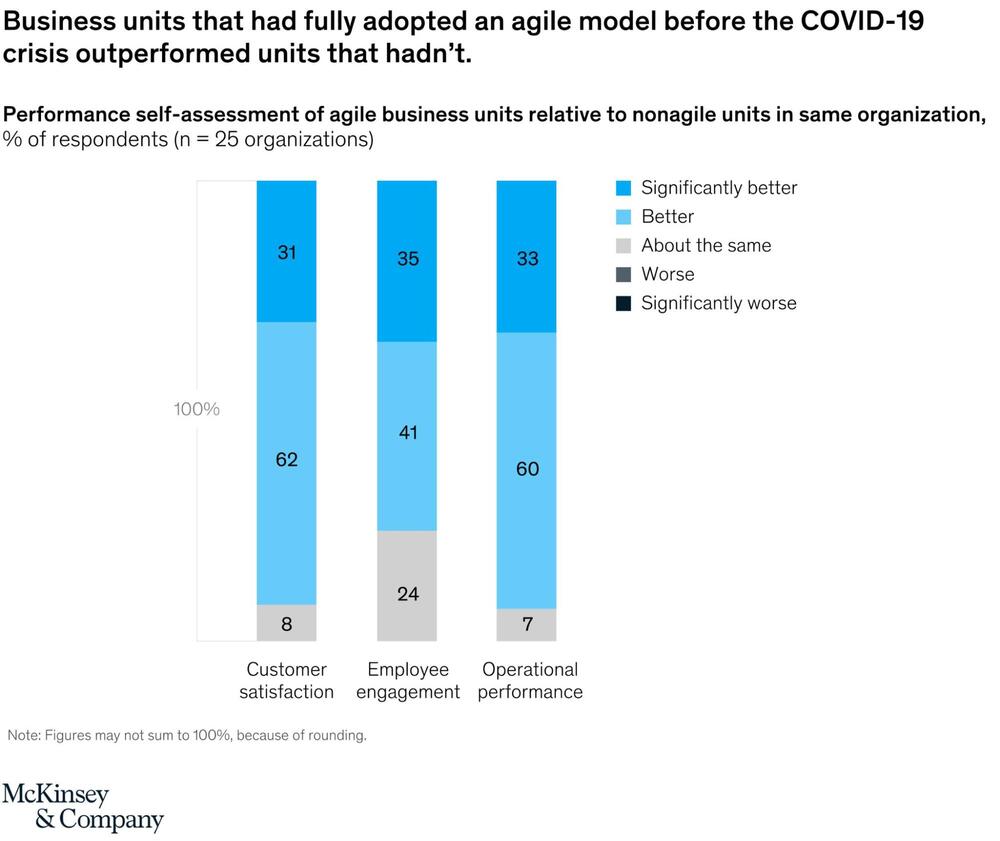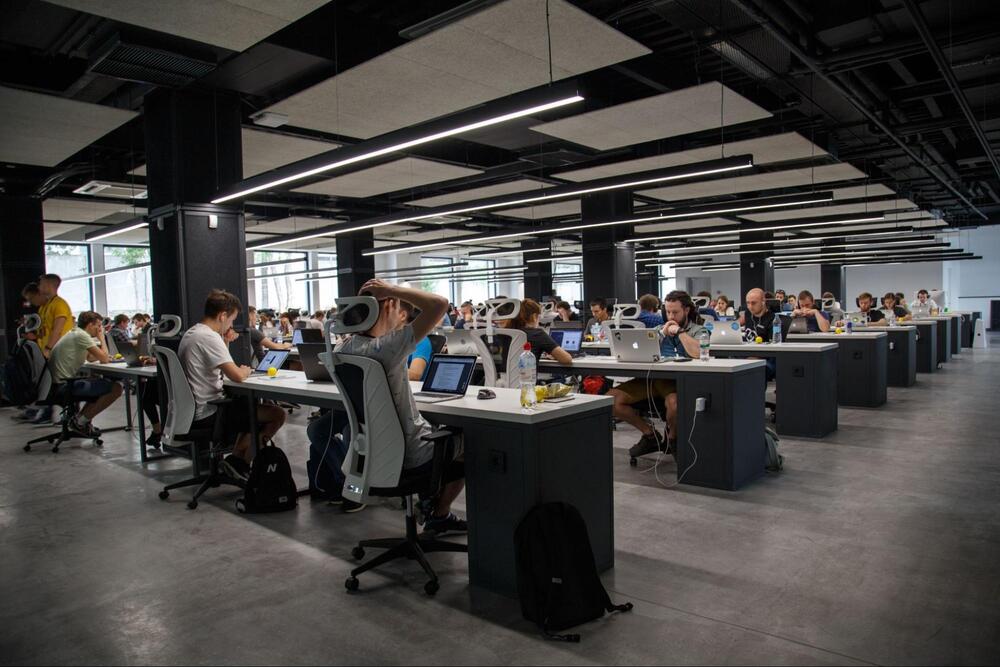Did you know that companies who adopt agile work environments can see a 237% growth in commercial performance? It’s no wonder organizations are increasingly turning to an agile work environment to leverage this flexible and effective approach.
However, developing a successful agile work environment is no easy task.
There are a range of workplace practices that can be adopted as part of an agile workplace revamp. But when, exactly, do you consider that a work environment is “agile”? And what can you do to improve agility in the workplace?
In this article, you will find information on what an agile work environment is, how it can benefit your business, and five agile practices you can adopt today.
What is an agile work environment?
Before we look at how to develop workplace agility, let’s first define what an agile work environment actually is.
The “Agile Manifesto” was first created by a group of software engineers. In the spring of 2000, they convened in order to discuss how they could increase the efficiency of bringing software projects to market.
Nowadays, the agile methodology of working has made its way into almost every industry.
An agile work environment is one that provides flexibility to workers. It allows them to work in a variety of ways that best suit them as individuals and the activities they are carrying out.
At its core, an agile work environment must be:
- People-led: Prioritize individuals and make tools accessible to them
- Adaptable: Respond to change rather than follow a plan
- Evolving: Learn from how your workplace is actually used
To build an agile workplace environment, you will need to invest in new infrastructure such as hot-desking systems, remote manager software, self-management solutions and digital collaboration tools such as Talkspirit. However, as we will discuss next, the benefits make the investment more than worth it.
What are the advantages of an agile work environment?
While we can’t say that one type of work environment is better than another, in practice, data from McKinsey shows there are many advantages to adopting an agile work environment.
An extreme, real-world case study occurred in 2020 when the global COVID-19 pandemic rocked the business world.
Many businesses struggled to get through this period. However, the vast majority of businesses that had adopted an agile approach prior to 2020 fared better in customer satisfaction, employee engagement, and operational performance than those that hadn’t.

This perfectly outlines one of the primary benefits of an agile workspace: adaptability.
Part of the reason why agile businesses are more adaptable is because they tend to have lower operating costs. As we will discuss later in this article, agile workplaces often encourage hot desking and remote working. Thus they often have lower overheads relating to rent and real estate.
This is great for adapting to extreme scenarios such as a pandemic. But it also simply means lower costs overall—and lower costs mean greater profits!
But increased profits don’t just stem from cutting costs. Agile businesses will also see higher revenue with greater employee productivity. This productivity largely stems from the increased efficiency and suitability of the environment in which your employees are working.
Agile practices mean workers always have an appropriate place to carry out their daily tasks, no matter their requirements, creating minimal compromise and maximizing efficiency.
5 ways to make your work environment more agile
Agile work practices often overlap, which can make them easy to integrate. It also means the various methods of creating an agile workspace are very complementary to one another.
Here are five ways to promote and foster an agile work environment.
1. Hot-desking
Hot-desking is a relatively well-established practice, having been first adopted at IBM in 1993. In a hot-desking work environment, employees do not have assigned desks. Rather, desks are available to be used as and when they are required.
Hot desks generally do not need to be reserved. Instead, they are taken on a first-come, first-served basis.

The advantage of hot-desking is that a company does not need to have the office space to provide one desk for every employee.
With business trips, meetings, and hybrid working, it is very rare that every employee is in the office at the same time. As a result, having a dedicated desk for each employee is an unnecessary cost. Used office space that could be repurposed for collaborative workspaces or social spaces, for example.
2. Activity-based working
Activity-based working (ABW) is centered on the fact that throughout a workday, an individual performs a range of different tasks, and not all of these tasks are best performed at a desk.
In recognition of this, an ABW environment provides a range of different types of workspaces intended for different activities.
Throughout the day, an employee may reply to some emails at a hot desk, collaborate on new ideas in a bookable social space, do some free thinking and research in a private nook, and then finish the day back at a hot desk.
3. Hybrid working
Hybrid working is becoming the new norm—and for good reason. It combines the advantages of remote work (reduced costs, higher productivity, increased employee satisfaction) and office-based work (improved collaboration and engagement).
Collaboration tools like Talkspirit can help companies adopt and implement a hybrid work model effectively. By giving hybrid teams one platform to communicate and collaborate on, managers ensure everyone can still access data securely and continue working productively whether they’re in the office or working from home.
In tandem with a hot desk model, hybrid working can be a huge cost saver. One mid-size IT company was able to save $1.2 million per year by adopting a hybrid model.

As those who have experience remote working will know, never going into the office can result in employees feeling disconnected from their team and can lead to demotivation. By going into the office on a regular basis, hybrid workers still maintain a strong connection with their employees and fellow colleagues.
4. Build an Agile tech team
If you are to implement agile workspace practices, it is essential that you have a tech support team that is well-adapted to this new way of working.
A traditional team of IT specialists who turn your computer off and on again every time there’s an issue won’t do. Agile working requires an innovative mindset, and your tech team’s approach should reflect that.
Moreover, they should have both soft skills and hard skills to ensure they can support employees under a hybrid work model. That includes IT skills like coding as well as communication, collaboration, and organization. Consider implementing a technical screening process when hiring IT staff to ensure new team members can adapt to this working environment.
5. Workspace analytics
To understand how your employees are using your new agile work environment and how you can improve it, you need to keep and analyze workplace analytics that measure the way people work under this model.
By keeping a log of when employees are working from home, using a hot desk, booking collaborative spaces, etc., you can optimize your work environment for your employees.
No two workspaces will be the same, and neither will the people working there.
For example, if you find most of your workforce is working remotely several days a week, you may need to invest in more digital infrastructure. This could be a phone service online, better remote working software, or even webcams.
Food for thought
Designing and implementing an agile workspace is an ever-evolving process. However, you should now feel well-equipped to go out there and transform your workspace for the better!
Remember, an agile work environment is beneficial for everyone in your team. It gives workers greater flexibility, which in turn boosts their productivity.
Agile really is a win-win, and starting needn’t be a huge step. Simply adopting hybrid working is a cheap and immediate way to start making your work environment more agile. So, get out there and start reshaping your team for success.
For more tips on how to adopt a hybrid work model, read our white paper:



![[Expert Opinion] Elmy’s Journey to Becoming a Mission-Driven Company](https://blog.talkspirit.com/wp-content/uploads/2024/11/How-to-become-a-mission-driven-company-400x250.jpg)
